They are cheaper than Greek, rarer than Roman, more bizarre than Byzantine, sexier than Anglo-Saxon, more British than English hammered, and more fun than foreign banknotes. That’s the magic of Celtic coins, the first coins made in Britain.
If Celtic coins are so unusual and so exciting, why don’t more collectors collect them? Good question. The answer is that until recently, British Celtic coins were hard to find, expensive to buy, and difficult to understand. In fact, until 400 years ago, nobody even knew of their existence; or if they did, they failed to mention it.
John Leland, who became “king’s antiquary” in 1533, spent six years searching for records of antiquities in the cathedral’s colleges, abbeys and priories of England. He says “he collected a whole world of things very memorable” but could not find a single ancient British coin. He attributed this apparent absence of early native coinage to the fact – first state by St. Gildas (ca. 493-570 A.D.), the Romano-British monk and historian – that the Romans Prohibited any metal being struck in Britain, except with the image of Caesar.
Rich Man’s Hobby
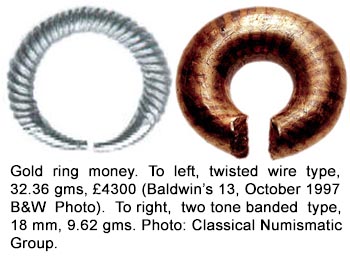 British Celtic coins were first published, with some woodcuts, in Britainia in 1586 by William Camden (1551-1623). Other early contributors include cartographer John Speed (1542-1629), collector Sir Robert Cotton (1571-1631), and antiquarian William Stukeley (1687-1765), known as the ‘Arch-Druid’. British Celtic coins were first published, with some woodcuts, in Britainia in 1586 by William Camden (1551-1623). Other early contributors include cartographer John Speed (1542-1629), collector Sir Robert Cotton (1571-1631), and antiquarian William Stukeley (1687-1765), known as the ‘Arch-Druid’.
In 1849 John Akerman drew the first distribution map of British Celtic coins and in 1864 John Evans published The Coins of the Ancient Britons, a masterpiece of numismatic scholarship. The work was enlarged in 1890 and is still worth studying over a century later. Derek Allen quietly dynamited ossified beliefs with his prolific papers and books published from the 1940s to the 1970s; the most explosive was The Origins of Coinage in Britain: a re-appraisal (1960). Allen’s research and insights provided the foundation for Richard Mack’s The Coinage of Ancient Britain (1953, revised in 1964 and 1975), the first popular textbook of Celtic coins.
But collecting “Ancient British” was still a rich man’s hobby in the 1950s, 60s and 70s. It tended to be the peripheral pursuit of a few brave ex-servicemen, such as Commander Mack, Major Clem Lister and “Pathfinder” Henry Mossop, DFC, who was shot down over the Rhine on 21 June 1944 and imprisoned for a year in Stalag Luft III.
Then three things happened over the next decade that encouraged the average collector to take a more active interest in Celtic coins. Metal detecting mushroomed as a popular hobby, which dramatically boosted supplies of Celtic coins. A dozen enlightened dealers – Spink to name but one – made these previously hidden supplies readily available at affordable prices. And Robert Van Arsdell, and American marketing man and perennial digger at Danebury hillfort, produced Celtic Coinage of Britain in 1989, the most comprehensive and comprehensible book about British Celtic coins.
These three factors – the growth of metal detecting, the increased availability of affordable coins and the publication of a well-written, well-illustrated textbook – meant that by 1990 Celtic coins were firmly placed on the numismatic map and on the collecting agenda. The aim of this article is to provide a brief introduction to British Celtic coins, in the hope that you, too, might look more closely at them.
Cross-Channel Trade
Before coinage was introduced to late Iron Age Britain, people conducted transactions by bartering their products, possessions and services. This process of payment and exchange may have been facilitated by gold “ring money” (most of which seems to date from the late Bronze Age); by neck torcs and arm bands of gold, silver and bronze; and by iron “currency bars” shaped like swords, spits, ploughshares and bay leaves, which appeared during the 2nd century B.C.
Celtic coins starting coming into Britain around 150 B.C. and continued to be imported until after the Gallic War in 50 B.C. These imports were mainly gold staters and quarter staters minted Gallia Belgica (northern France) and copied from copies of gold staters of Philip II of Macedon. Some of the Gallo-Belgic coins came with immigrant settlers and others may have come with British mercenaries returning home after fighting the Romans in Gaul; but most of the imported coins were probably the result of cross-Channel trade, which included slave trading. The Greek geographer Strabo (ca. 60 BC to A.D. 20), whose name means “squint-eyed”, lists as the principal exports of Britain “grain, cattle, gold, silver and iron … also hides and slaves and dogs that are by nature suited to the purposes of the chase.”
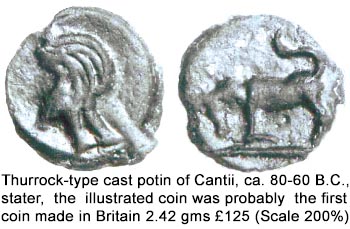 Around 80-60 B.C. a Kentish tribe, probably the Cantii, produced the first coins that were actually made in Britain. These imitated coins of Massalia (Marseilles) and were cast, not struck, in a tin-rich bronze alloy called “potin”. Collectors call them Thurrock potins, named after a hoard of about 2,000 potin coins found in a pit at West Thurrock, Essex, in 1987. Around 80-60 B.C. a Kentish tribe, probably the Cantii, produced the first coins that were actually made in Britain. These imitated coins of Massalia (Marseilles) and were cast, not struck, in a tin-rich bronze alloy called “potin”. Collectors call them Thurrock potins, named after a hoard of about 2,000 potin coins found in a pit at West Thurrock, Essex, in 1987.
The first gold coins made in Britain, ca. 70-60 B.C., also come from Kent and are known as Kentish A staters. These may have been issued by the Cantii to pay British soldiers to fight Diviciacus, king of the Suessiones, a Gaulish tribe who inhabited the region around Noviodunum (Soissons, northern France). Caesar says that Diviciacus was at one point the most powerful ruler in Gaul and that he held sway over part of Britian (almost certainly Kent).
Cassivellaunos & Caesar
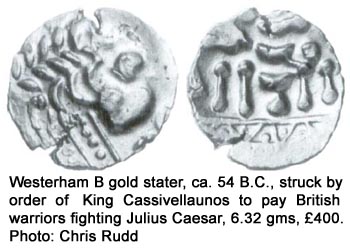 In 54 B.C. Caesar himself invaded Britain for the second time and reports that he was confronted by a coalition of British tribes commanded by Cassivellaunos, who was probably king of the Catuvellauni tribe. In order to fund the campaign against Caesar, it is possible that Cassibvellaunos ordered an emergency issue of gold coins north and south of the Thames, which are today called Ingoldisthorpe and Westerham staters after the places where they first found. These emergency war coins are often crudely engraved and clumsily struck, which suggests they were made in a hurry. In 54 B.C. Caesar himself invaded Britain for the second time and reports that he was confronted by a coalition of British tribes commanded by Cassivellaunos, who was probably king of the Catuvellauni tribe. In order to fund the campaign against Caesar, it is possible that Cassibvellaunos ordered an emergency issue of gold coins north and south of the Thames, which are today called Ingoldisthorpe and Westerham staters after the places where they first found. These emergency war coins are often crudely engraved and clumsily struck, which suggests they were made in a hurry.
Before Caesar sailed back to Belgica in 54 B.C. he imposed a heavy tax on the Celtic coalition tribes of Britain, to be paid each year by their commander in chief, Cassivellaunos. The threat of a third invasion was a serious one, because it could rapidly have resulted in the Roman occupation of south-east England (as it did a century later). It is therefore likely that Cassivellaunos honoured his treaty with Caesar and paid the annual tribute at least until Caesar left Gaul in 51 B.C., when the risk of defaulting would have diminished. It is also likely that Cassivellaunos would have raised the money each year by taxing not only the people directly under his protection, but by bullying gold bullion out of neighbouring tribes too, such as the Atrebates, Durotriges, Eceni and Coreiltauvi.
John Sills attributes this yearly taxation to the huge amount of gold staters – Whaddon Chase, Atrebatic Abstract, Chute, Norfolk Wolf, North East Coast – which suddenly and simultaneously seem to have been struck episodically for some years shortly after Caesar’s second invasion. The idea is pure speculation, of course, but plausible.
For the first fifty years of British minting, most of which was highly sporadic and localized, almost all the coins were uninscribed and we can only guess who produced them, when, where and why. Unlike the Greeks and Romans, the Celts wrote no books and little is known of Celtic rulers, their moneyers and their mint sites. So any discussion about late Iron Age coin production, especially attribution and dating, is usually hypothetical, whoever scholarly it may seem.
Between ca. 60 B.C. and ca. 30 B.C. many uninscribed silver coins and a few bronze coins were struck. The early gold coins were standardized in style – all variations on the Apollo-head-and-horse theme – and were probably used solely by tribal leaders and their elite classes for very specific purposes (e.g.: warrior wages, bribe price and tribute money). Whereas the early silver and bronze coins were less tightly controlled, less conservative in design, carry a vast variety of different images, and were probably used for everyday commerce by farmers, merchants, craftsman, priests and other well-to-do members of the community.
Commios
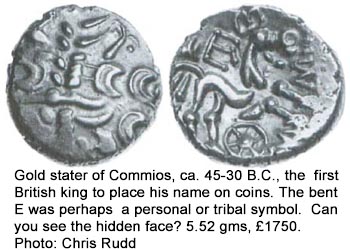 Around 45-30 B.C. King Commios of the Atrebates struck the first British coin to bear the ruler’s name. Philip de Jersey writes: “Since at least the start of the 17th century this Commios has been taken to be the same Gaulish chieftain who ‘had rendered Caesar loyal and useful service in Britain’ (De Bello-Gallico VII, 76) where he was ‘greatly respected’ (op.cit. IV, 21). Commios later turned against Caesar, however, and in 51 B.C. he was one of the leaders of the Gaulish force which attempted to relieve the siege at Alesia, the site of Caesar’s victory over Vercingetorix. A year or so after the failure of that invasion, following further skirmishes with Rome, Commios offered hostages to Antony ‘as a guarantee that he would live where he was bidden and do as he was told’ (op. cit. VIII, 48). Antony is said to have accepted his petition, but rather than living ‘where he was bidden’ Commios is thought to have fled back to Britain in about 50 B.C.” Around 45-30 B.C. King Commios of the Atrebates struck the first British coin to bear the ruler’s name. Philip de Jersey writes: “Since at least the start of the 17th century this Commios has been taken to be the same Gaulish chieftain who ‘had rendered Caesar loyal and useful service in Britain’ (De Bello-Gallico VII, 76) where he was ‘greatly respected’ (op.cit. IV, 21). Commios later turned against Caesar, however, and in 51 B.C. he was one of the leaders of the Gaulish force which attempted to relieve the siege at Alesia, the site of Caesar’s victory over Vercingetorix. A year or so after the failure of that invasion, following further skirmishes with Rome, Commios offered hostages to Antony ‘as a guarantee that he would live where he was bidden and do as he was told’ (op. cit. VIII, 48). Antony is said to have accepted his petition, but rather than living ‘where he was bidden’ Commios is thought to have fled back to Britain in about 50 B.C.”
The Commios who issued Britain’s first branded coins may be the Commios of Caesar’s De Bello-Gallico or it may be his son of the same name; opinion is divided on this matter. What is undisputed is that the self-publicity of Commios I or Commios II quickly brought other rulers into the advertising business, in much the same way that John F. Kennedy’s presidential campaign of 1960 prompted other tribal chieftains around the world to turn politics into a personality cult.
Robert Van Arsdell writes: “Commios had started the practice by placing his name on the Atrebatic/Regnan staters about 45 B.C. Addedomaros promptly responded to this display of vanity by emblazoning his entire name across the Trinovantian/Catuvelliaunian ones. This one-upmanship game spread quickly to the other tribes and by the end of the millennium all but the Durotriges and Eceni were striking inscribed types.” The Durotriges had been commercially marginalized by the Atrebates; and the Eceni, surrounded by sea-water and marsh-water, had apparently become an independent “island state”.
Dynastic Warfare
Britain’s coinage of the first four decades of the new millennium was largely dominated, whether directly or indirectly, by the growth of – and by the inter-tribal battles between – the two most powerful Celtic dynasties: the house of Commios south of the Thames and the house of Tasciovanus north of the Thames, with Essex, Kent and north Hapshire being the most hotly disputed war zones.
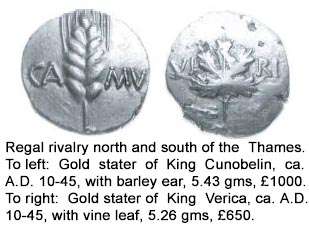 Both royal dynasties adopted Roman-style designs adopted Roman-style designs on their coins (a few of their dies may even have been cut by Roman engravers). Both displayed the king’s name boldly. Both boasted of their military prowess, with gold coins depicting armoured cavalrymen charging into battle wearing helmet and chain mail, and brandishing a sword or war trumpet. And both sometimes featured overtly competitive images on their coins. For example, at about the same time that King Cunobelin of the Catuvellauni and Trinovantes had a big ear of barley on his gold staters, alluding perhaps to his grain exports or beer brewing, King Verica of the Atrebates and Regni – not to be out-shouted by his rival north of the Thames – placed a large vine-leaf on his gold staters, referring maybe to all of the fine Roman wine that he was importing from Gaul and distributing to his courtiers at Celtic festivals and regal feasts. Such public displays of largesse were a significant factor in boosting – often with prolonged boozing – the prestige and popularity of Iron Age warrior kings. Both royal dynasties adopted Roman-style designs adopted Roman-style designs on their coins (a few of their dies may even have been cut by Roman engravers). Both displayed the king’s name boldly. Both boasted of their military prowess, with gold coins depicting armoured cavalrymen charging into battle wearing helmet and chain mail, and brandishing a sword or war trumpet. And both sometimes featured overtly competitive images on their coins. For example, at about the same time that King Cunobelin of the Catuvellauni and Trinovantes had a big ear of barley on his gold staters, alluding perhaps to his grain exports or beer brewing, King Verica of the Atrebates and Regni – not to be out-shouted by his rival north of the Thames – placed a large vine-leaf on his gold staters, referring maybe to all of the fine Roman wine that he was importing from Gaul and distributing to his courtiers at Celtic festivals and regal feasts. Such public displays of largesse were a significant factor in boosting – often with prolonged boozing – the prestige and popularity of Iron Age warrior kings.
However, despite their love of Roman wine and finery, these Celtic kings were, by our standards, still brutal warlords whose power-base and expansion plans were firmly founded on clan feuding, land grabbing, cattle raiding and slave trading. It was the sons and grandsons of King Tasciovanus who proved most successful in their aggressive aggrandizement and, by the eve of the Claudian invasion of A.D. 43, they controlled all the land and all the people in south-east England. The distribution of the coins of King Cunobelin, his brother Epaticcus and his sons Caratacus and Amminus testify to the dominant strength of the north-Thames royal dynasty.
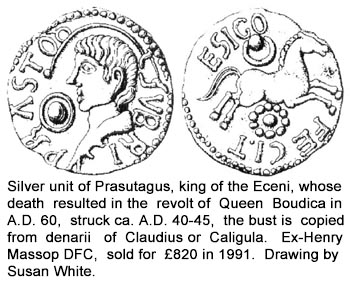 Within a couple of years of the Roman invasion it is likely that the minting of Celtic coins in Britain was completely suppressed. The cast bronze coins of the Durotriges, minted at Hengistbury Head, Dorset, were probably the last Celtic coins made in Britain, possibly as late as A.D. 45. There is also a possibility that some extremely rare silver coins inscribed SVBRHPRASTO ESICO FECIT may have been struck shortly after the Roman conquest by the Ecenian client-king Prasutagus, husband of the rebellious Boudica. If he did, then one wonders how he managed to secure this preference to other more deserving, more obviously pro-Roman allies such as Tiberius Claudius Cogidubnus, who actively facilitated the Claudian invasion of Britain by providing a safe landing place. Within a couple of years of the Roman invasion it is likely that the minting of Celtic coins in Britain was completely suppressed. The cast bronze coins of the Durotriges, minted at Hengistbury Head, Dorset, were probably the last Celtic coins made in Britain, possibly as late as A.D. 45. There is also a possibility that some extremely rare silver coins inscribed SVBRHPRASTO ESICO FECIT may have been struck shortly after the Roman conquest by the Ecenian client-king Prasutagus, husband of the rebellious Boudica. If he did, then one wonders how he managed to secure this preference to other more deserving, more obviously pro-Roman allies such as Tiberius Claudius Cogidubnus, who actively facilitated the Claudian invasion of Britain by providing a safe landing place.
Five Main Denominations
It has been estimated that about 70,000 Celtic coins have been found in Britain, mostly by metal detectorists during the last twenty years. Over 23,000 of these have been recorded by the Celtic Coin Index at the Institute of Archaeology, Oxford. Yet, strangely, despite this mass of material, much of which has been meticulously studied by numismatists, we still do not know what Celtic people called their coins or what values they placed on them.
Commenting on Continental Celtic coins, Derek Allen writes: “Although for convenience coins are usually described by the Greek or Roman names of the denominations that were imitated, we do not in fact know the true names for the coins. There is a single exception, a heavy bronze coinage of post-conquest date of the Lexovii (Lisieux), which has an inscription giving the denomination as sentissos publicos; this is a Celtic version of the Latin Semis, half an as in the Roman system. The occasional presence of an S on the other bronze coins, all of much light weight, may warrant the assumption that the semis (marked with S on Republican Roman coins) was the normal name of the small bronze used in Gaul”. And maybe a bronze coin was called a semis in Britain too.
In Britain there were five main Celtic denominations which collectors classify as: gold staters, gold quarter staters, silver units, silver minims, and bronze (or potin) units.
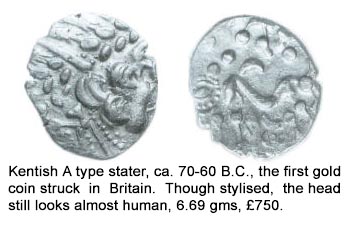 Gold staters were the principle denomination of pre-Roman Britain. The first to cross the Channel in considerable quantities, known as Gallo-Belgic Goddess or Large-Flan Ambiani, is a gorgeous golden gold, has a diameter of up to 27 mm, and weighs 7.8 gms – a magnificent coin by any standards. The first gold stater made in Britain, the Kentish A, ca. 70-60 B.C., is 19 mm, weighs 6.7 gms and also has a golden colour. Gold staters were the principle denomination of pre-Roman Britain. The first to cross the Channel in considerable quantities, known as Gallo-Belgic Goddess or Large-Flan Ambiani, is a gorgeous golden gold, has a diameter of up to 27 mm, and weighs 7.8 gms – a magnificent coin by any standards. The first gold stater made in Britain, the Kentish A, ca. 70-60 B.C., is 19 mm, weighs 6.7 gms and also has a golden colour.
After the Gallic War, supplies of gold bullion became scarcer and British staters became small, lighter, and less golden, ending up with an average weight of 5.4 gms and with an orangey or pinkish tinge to them, depending on how much copper the moneyer poured into his smelting pot.
To compensate for the shortage of gold, or perhaps to swindle, staters were often made with a bronze core, and then plated with gold – and plated so well that you wouldn’t have known they were “forgeries”. Durotrigan moneyers seemed to have run out of gold altogether because, by ca. 50 B.C., they were making only silver staters weighing barely 3.0 gms.
Gold quarter staters are 8 mm. to 14 mm. in diameter, weigh 1.0 gm to 2.0 gms on average, and are comparatively scarce as a denomination (fewer were minted). They offer good value to the collector, because most people prefer to collect staters, which means quarters are still relatively under-priced.
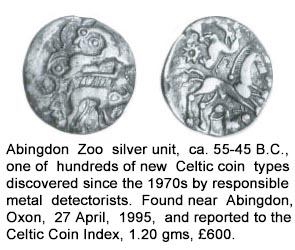 Silver units are 11mm. to 15mm., weigh about 1.0 gm on average and offer a dazzling diversity of designs, many of them copied from contemporary Roman denarii. Many new types of silver units have turned up since 1975 as a result of metal detecting and the eagle-eyed collector always has a chance of picking up unpublished varieties. Silver units are 11mm. to 15mm., weigh about 1.0 gm on average and offer a dazzling diversity of designs, many of them copied from contemporary Roman denarii. Many new types of silver units have turned up since 1975 as a result of metal detecting and the eagle-eyed collector always has a chance of picking up unpublished varieties.
Silver minims are about 8 mm, weigh 0.3 gms and were issued mostly by the Atrebates, ca. 25 B.C.-A.D. 43, though earlier types exist. They are miniature masterpieces of the Celtic die cutter’s craft and, since the Wandborough hoard was unearthed in 1984 (damaging a Romano-Celtic temple site), thousands have come onto the market, some of them previously unknown.
Bronze and potin units, both struck and cast, vary widely in size and weight and are often corroded after 2,000 years in the soil. Very Fine specimens with an even green patina consequently  command high prices. But, if you aren’t too fussy about condition, you can quickly assemble an interesting and varied collection of Celtic bronze and potin coins, especially north Thames types. command high prices. But, if you aren’t too fussy about condition, you can quickly assemble an interesting and varied collection of Celtic bronze and potin coins, especially north Thames types.
Eleven Coin Tribes
Eleven tribal groups issued coins in late Iron Age Britain. The word ‘tribe’ must be used cautiously in this context and chiefly as an approximate indication of geographic and socio-economic areas. Barry Cunliffe writes: “In the late Iron Age Britain can be divided into three broad zones: a core comprising the south-east which shared many cultural characteristics with the Continent; a periphery comprising an arc of coin-issuing tribes stretching from Dorset to Lincolnshire; and a beyond, that is the rest of Britain west and north of the periphery here coinage had not been introduced into the economy.” (Iron Age Communities in Britain, Routledge 1991, p.130).
From about 25 B.C. the cultural aspirations and coinage of the core tribes in the south-east became increasingly Roman in style and may be termed Romano-Celtic, while the coinage of the peripheral tribes remained markedly un-Roman in appearance and may be called ethno-Celtic. We shall consider the core tribes first, which lay south and north of the Thames, beginning with the Cantii who made the first British coins.
Corner-Land People
The Cantii (or “Cantiaci” as the Ravenna cleric of ca. A.D. 700 refers to them) occupied territory today known as Kent and the late Iron Age boundaries seem to match the modern county boundaries, just as the county name closely resembles the Celtic name, Julius Caesar mentions four kings of the Cantii – Cingetorix, Carvilius, Taximagulus and Segovax – but does not say where or when they ruled in Kent, nor whether simultaneously or successively, Kentish coin finds suggest that there could have been four individual socio-economic groups in the region, based on the rivers Stour, Medway, Darent and on the Weald. The separate nature of the three coastal groups is further supported by distribution patterns of different Iron Age pottery fabrics. It is therefore possible that Cingetorix, Carvilius, Taximagulus and Segovax ruled these four Cantian groups at the same time and were responsible for issuing the uninscribed Celtic coins around the period of the Gallic War or shortly afterwards.
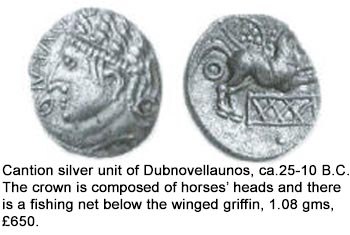 The name Cantii may mean “people of the corner land”. Cantian tribal centres and mint sites were probably at Canterbury (Durovernum “alder fort”) and Rochester (Durobrivae “bridge fort”) where clay moulds for coin flans have been found. The importance of fishing to the Celtic communities of Kent is reflected in a rectangular fishing net which is seen on several of their early coins. After the Gallic War the importance of the Cantii appears to have declined and the tribes of Kent were peripheral to the economic expansion enjoyed by those north of the Thames. As Cunliffe says, it may be that they were deliberately excluded from trading contacts with the Roman province of Gaul because of their violent opposition to Caesar in 55 and 54 B.C. The name Cantii may mean “people of the corner land”. Cantian tribal centres and mint sites were probably at Canterbury (Durovernum “alder fort”) and Rochester (Durobrivae “bridge fort”) where clay moulds for coin flans have been found. The importance of fishing to the Celtic communities of Kent is reflected in a rectangular fishing net which is seen on several of their early coins. After the Gallic War the importance of the Cantii appears to have declined and the tribes of Kent were peripheral to the economic expansion enjoyed by those north of the Thames. As Cunliffe says, it may be that they were deliberately excluded from trading contacts with the Roman province of Gaul because of their violent opposition to Caesar in 55 and 54 B.C.
Settlers & Stiff Ones
The main core tribes south of the Thames were the Atrebates and Regni who, for numismatic purposes, are most conveniently regarded as a single tribal entity during the late Iron Age period, dominated by the Atrebates. The Regni go almost unrecorded in history until the Roman period.
Atrebatic/Regnan territory embraced Surrey, Sussex, Berkshire and parts of Hampshire and Wiltshire. The Atrebates came first into historical perspective when King Commios arrived in Britain to re-unite with his kinsfolk who had already settled here, after fleeing from Caesar. Commios was a king of the Gallo-Belgic Atrebates and it was probably from this time onwards that his British followers were known by the tribal name and that other Gallo-Belgic settlers of south and east Hampshire, known as the Belgae, were overshadowed by the Atrebates.
The name Atrebates may mean “the settlers” or “the inhabitants” and Regni or Regini may mean “the stiff ones”. Atrebatic/Regnan coins were almost certainly minted at the tribal centres of Silchester (Calleva “town in the woods”) and Chichester (Noviomagus “new market”) and maybe also at Boxgrove. Early uninscribed coins of the Atrebates and Regni frequently feature a triple-tailed horse. Later issues show a strong Roman influence.

Men Good in Battle
The core tribes north of the Thames were the Catuvellaauni and Trinovantes. Both Cunliffe and Van Arsdell say, “it is impossible at present to distinguish the coinages of the two tribes.” Recent interpretations of the coin evidence suggest, however, that a distinction should be made, at least until the time of Cunobelin. I shall therefore dis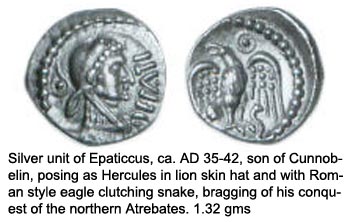 cuss the two tribes separately. cuss the two tribes separately.
Commander R.P. Mack writes: “The area occupied by the Catuvellauni covers roughly the counties of Bedfordshire, Hertfordshire, Huntingdonshire and Cambridge, with parts of Buck, Essex, Northants, Oxfordshire and Suffolk, but its boundaries were continually changing, and it is hard to lay don any limits. The Catuvellauni are first mentioned in history under their King Cassivellaunos putting up a stiff resistance to Caesar in 54 B.C., and the probability is that they were the most powerful tribe in Britain at that time … The first king of the Catuvellauni to place his name upon his coins was Tasciovanus, a king completely unknown to history.”
The name Catuvellauni may mean “men good in battle” – they were certainly a bellicose tribe – and coins were probably minted at their capital, Verulamion (modern St. Albans) and at Braughing. Many uninscribed coins of the Catuvellauni show a winged symbol, which may have been a tribal emblem.
Very Lively Ones
By the reign of King Cunobelin the most powerful core tribe north of the Thames was the Trinovantes who occupied the whole of Essex and southern parts of Suffolk. Caesar says that the Trinovantes were enemies of the Catuvellauni and it was the Trinovantes who supplied him with provisions when he landed for the second time in 54 B.C. Prior to Cunobelin, the only known rulers of the Trinovantes were Mandubracius, a prince whose father was killed by Cassivellaunos, and Addedomaros and Dubnovellaunos who both struck inscribed coins. Dubnovellaunos also held land in Kent.
The name Trinovantes may mean “the very lively ones” and the principle mint site was probably at their tribal centre at Colchester (Camulodunon “fort of Camulos”). Many early coins of the Trinovantes carry to opposed crescent moons – one waxing, the other waning – as do early coins of the Catuvellauni and the Eceni. In the eastern part of England, with its comparatively flat land and correspondingly broad sky, the moon was perhaps of greater significance to these Celtic communities, because of its prominence in the night sky and its importance in the farming cycle.
Culture Follows Power
The so-called peripheral or ethno-Celtic tribes that produced coins are the Belgae, Durotriges, Dobunni and East Wiltshire people to the south and west of the Thames, and the Eceni and Corieltauvi to the north and east of the Thames. The character of their coins remained resolutely un-Roman, whereas the coins of the Cantii, Atrebates, Regni, Catuvellauni and Trinocantes grew steadily pro-Roman in style from about 25 B.C. When America became the leading political power by the end of the Second World War, its cultural trappings, such as Coca-Cola and Frank Sinatra, became increasingly popular in Britain. Similarly, when Rome made itself the key player in Europe by the end of the Gallic War, Roman culture in the form of wine-filled amphora became increasingly popular with the British tribes who could afford to import it. The, as now, culture follows power.
Proud Ones
Consigned to obscurity by Evans, Allen, Mack, Van Arsdell and most other numismatists, the Belgae of south-coast Britain are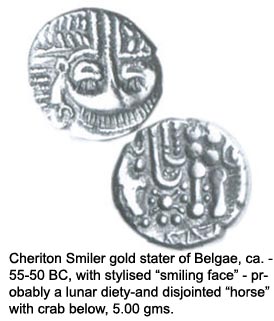 now making a come-back after 2,000 years of near oblivion. Originally based on immigrant settlers around the Solent, Itchen and Test, the Belgae occupied most of modern Hampshire, probably including the Isle of Wright (Latin Vectis, British Vecta, “in the fork” or “watershed”). The name Belgae may mean ‘the proud ones’ and Belgic coins were probably made initially at a coastal mint site and later at Winshester (Venta Belgarum “market of Belgae”). now making a come-back after 2,000 years of near oblivion. Originally based on immigrant settlers around the Solent, Itchen and Test, the Belgae occupied most of modern Hampshire, probably including the Isle of Wright (Latin Vectis, British Vecta, “in the fork” or “watershed”). The name Belgae may mean ‘the proud ones’ and Belgic coins were probably made initially at a coastal mint site and later at Winshester (Venta Belgarum “market of Belgae”).
Cunliffe comments: “Caesar, writing in the middle of the first century B.C., referred in passing to an invasion of Belgae into Britain at some unspecified time in the past. While it has usually been argued that the invaders settled in Kent and the Thames valley region and that the Gallo-Belgic coins were associated with the incoming, this now seems less likely. A case can be made out for a limited (but archaeologically invisible) incursion into the east Solent region penetrating Hampshire. The strongest evidence for this is that under the early Roman reorganization of the province this area of Hampshire, with Winchester as its centre, was known as the canton of the Belgae’ (Iron Age Britain p.63-64).
At least half a dozen distinctive coin types, such as Cheriton, Chute Transitional, Thin Silver, Chichester Cock and various Danebury and Hayling Island types – traditionally attributed to the Durotriges or Atrebates – should probably be assigned to the British Belgae.
Water-Rat Kings
The Durotriges were a close-knit confederacy of smaller units centred upon present-day Dorset. They were a sea-faring Roman-loathing tribe whose territory corresponded closely to that of Anglo-Saxon Wessex. To the north the Wylyle defined their boundary with the Atrebates. To the east the Avon marked their boundary with the Belgae. To the west Durotrigan coins and pottery extend along the valley of the Yeo and Parrett, giving the tribe limited access to the Bristol Channel.
Cunliffe says: “The history of the Durotriges can be divided into two broad phases, an early phase, roughly 100-60 B.C. and a late phase from 60 B.C. until the Roman conquest. The early phase was a time of rapid development brought about by overseas trade, while the late phase was a time of retraction, isolation and economic impoverishment.” The economic decline of the Durotriges is dramatically portrayed by the progressive debasement of their coinage, particularly when you compare the magnificent white-gold Craborne Chase staters of ca. 50-40 B.C. with the crude cast bronze Hengistbury coins of ca. A.D. 10-43.
The name Durotriges may mean “dwellers by the water” or “the water-rat kings” (strangely enough, a rat can be seen on a Durotrigan silver quarter stater). Their prime tribal centre was probably Maiden Castle and coins were minted at Hengistbury Head and other sites, possibly Badbury Rings.
Medlar Tree
The Dobunni were a Cotswold tribe focused on Gloucestershire, Worcestershire and Avon, extending to the river Brue on Somerset, north and west Wiltshire and west of the Cherwell in Oxfordshire. Dobunnic coin distribution forms two clusters of concentration, approximately divided by the Bristol Avon, and may therefore represent two power bases within the single tribal territory. A similar two-fold split can be detected in Dobunnic pottery and its distribution in the 1st century B.C.
The northern centre of the Dobunni was at Bagendon, Gloucestershire – evindence of minting was excavated here – and the southern centre may have been at Bath or at Camerton in Somerset.
The meaning of the name Dobunni is uncertain, but the meaning of the tribe’s Roman capital – Corinium – may be “medlar-tree”, which may provide the identity of the Dobunni’s tree-like emblem, which is prominently displayed on their gold staters, except those issued by Boduoc. The medlar is a small Eurasian tree (mespilus germanica) of the rose family; it bears a fruit resembling a crab apple, known in Welsh as ceri. The name Corin may have been newly given to the Roman fort at Cirencester or, more likely, was transferred from the Dobunnic oppidum at Bagendon, which lies just three miles to the north.
East Wiltshire
To the east of the Dobunni there may have been a separate tribal group whose name is unknown and who for convenience is labeled “East Wiltshire.” Allen and Van Arsdell both refer to the coinage of this area as “Dobunnic irregular” and in 1989 Van Arsdell claimed that “recent finds have occurred in other parts of Dubunnic territory, however, today it is difficult to prove a ‘sub-Dobunnic’ coinage actually existed”. During the last decade, however, further new East Wiltshire types have come to light, such as Wiltshire Wheels and Vale of Pewsey gold quarters and Snake Head, Upavon Moon Head, Potterne Moon Head and Wiltshire Wings silver units.
It seems more sensible to attribute these new types, together with the Savernake Forest staters and Savernake Wheel quarter, to a distinct tribal group that was centred on the Vale of Pewsey, the northern part of Salisbury Plain to the Marlborough Downs, and the Upper Thames, Bristol Avon and Kennet forming its natural boundaries.
Like the Dobunni, these East Wiltshire people developed their own coinage later than other tribes, possibly around 30 B.C., and it may have ceased altogether by A.D. 30, when Vale of Pewsey probably fell under the sway of Cunovelin.
Horse People
The Eceni or Iceni (depending on whether you follow the spelling on their coins or the spelling in Tacitus’ Annals and the Antonine Itenerary) were an independent East Anglian tribe occupying all of Norfolk, north Suffolk and parts of the Cambridgeshire fenland, stretching to the Nene valley.
The Eceni do not slip as easily into Culiffe’s core and periphery classification as do the Catuvellauni and Trinovantes, who probably overshadowed them prior to the Roman invasion. Throughout the late Iron Age period the Eceni appear to be a wealthy and politically independent tribe and, as Cunliffe says, ‘The material nature of the territory differs little from that of the south-east … No other tribal area has yet yielded such vivid evidence of opulent aristocratic display.’ On the basis of their on-going opulence one might regard the Eceni as part of the south-eastern core.
However, the character of Ecenian coinage indicates that these Norfolk-centred folk were decidedly more ethno-Celtic than Romano-Celtic. Apart from a few silver coins of King Prasutagus, which may or may not have been issued after A.D. 43 (I’d say not), the coins of the Eceni remain unmistakably Celtic in style, even their later inscribed types.
The name Eceni may mean “the tribe” or “horse people”, the latter being more likely, and the “c” is hard, as in Ickworth, Icklingham and Icknield Way, the Neolithic trackway, “the road leading to their land”. Tony Gregory stated: “It is interesting that the only survival of the name of the tribe, apart from place names, is the adjective ickeny which was used in the dialect of Norfolk and Lincolnshire for things awkward and difficult to manage, and particularly for difficult horses. Could this have been a memory of the Eceni as horse dealers and breeders?” (Celtic Fire & Roman Rule, p.17).
A.L.F. Rivet and Colin Smith say: “The equation of Caesar’s Cenimagni with the Eceni has contextual and linguistic support. Caesar mentions them among the five tribes which submitted to him, perhaps because of their importance, but possibly also because it was against them that the friendly Trinovantes were being defended…An association of the British tribe by blood etymology with the Gaulish Cenomanni seems unlikely”. (The Place-names of Roman Britain, p.374).
There seem to have been at least three tribal centres in the region of the Eceni – Caistor St. Edmund (later Venta Icenorum “market of the Eceni”), Thetford and Saham Toney. Each had associated defensive earthworks, which might suggest that the Eceni were originally an amalgam of clans, rather than a single tribal entity. Ecenian coins may have been struck at Thetford, Saham Toney and Needham (clay flan moulds have been found at all three places) and maybe also at Lackford. Here the Celtic name, Camboritum “the ford at the bend”, may be recorded on silver coins inscribed Cans Duro (the workd duro was often added to names of wet settlements).
The Corieltauvi
As recently as forty years ago it was generally thought that the Brigantes were “the northern-most tribe of non-Belgic Britain to strike coins” and that “very few coins have been found in the area of the Coritani and it is not at all certain that they had a regular coinage of their own”. (R.P. Mack, The Coinage of Ancient Britain, 1st edition, 1953, p127-128). Today nobody believes that the Brigantes made any coins. Today only a few old codgers croak nostalgically about the Coritani.
The Corieltauvi have arrived and it looks like they are here to stay. Previously known as the Coritani, until the correct names was found on a tile in 1965 (R.S.O. Tomlin, Antiquaries Journal, 1983). The Corieltauvi were and East Midlands tribe centred on the uplands of parts of Lindsey and eventually occupying Lincolnshire, Leicestershire, Nottinghamshire, parts of the Humberside and perhaps parts of Derbyshire and South Yorkshire.
Van Arsdell says: “The Corieltauvi for many years were thought to be a backward tribe, untouched by the changes transforming southern Britain. This view has been proved false by archaeological studies made after 1960. They are now known to have been a most advanced tribe – early to adopt the potter’s wheel, for example…The coinage was one of the earliest struck in Britain…The Corieltauvi used complex privy marks for die control, weight specification and perhaps even identification of metallurgical content. The sophistication of the coinage is only now being appreciated and the next few years should produce some astounding findings”.
Corieltauvian tribal centres were probably located at Dragonby, Old Sleaford, Lincoln (Lindo “lake river”) and Leicester (Ratae “ramparts”) with other major settlements at South Ferriby, Kirmington, Owmby, Ludford, Horncastle, Ulceby Cross and Ancaster. Coins were probably struck at Old Sleaford where over 4,000 fragments have been found (by far the largest deposit of such debris in all Europe) and also at other unidentified mint sites.
Rarity & Cost
Ask a metal detectorist how many Celtic coins he or she has found and you will discover they are much scarcer than Roman coins – at least a thousand times scarcer on average.
This is because far fewer Celtic coins were minted than Roman coins, in smaller runs, and over a much shorter time span. Though some may have been made in Britain as early as 80 BC, the majority of British Celtic coins were minted between 54 BC and AD 43- barely a century of production, and most of that seems to have been sporadic.
However, the greater rarity of Celtic coins doesn’t mean they are more costly than other ancient coins. In fact, they are often cheaper, because there are fewer Celtic collectors and because demand determines price. For example, a very fine Celtic gold stater typically costs half the price of a Greek gold stater or an English gold noble of comparable quality and rarity.
Quoting averages can be misleading, but the average UK retail prices for very Celtic coins are approximately as follows” silver minims £50-£100, silver units £50-£150, cast potins £40-£80, struck bronzed £75-£175, gold quarter £150-£250, gold staters £250-£500. Fine specimens cost less than half these prices and extremely fine examples (exceptional in the Celtic series) are usually more than twice the VF price. The prices quoted in the photo captions of this article are of high caliber or high rarity coins I’ve sold recently and are therefore high than average.
Where to Begin
If you are considering buying some Celtic coins – and I can’t think of a more exciting series to collect – there are two things you should do first: read and see. Read Celtic Coinage in Britain by Philip de Jersey (Shire Archaeology, 1996, £5.50 including postage). It’s the best little book ever written on Celtic coins, with over 100 twice-size photos.
Then see some real Celtic coins at one of the following museums, all of which hold major collections. But phone first to check what is on display and what may be viewed by appointment.
Ashmolean Museum, Beaumont Street, Oxford OX1 2PH. Tel: 0186 527 8000. Birmingham Museum & Art Gallery, Chamberlain Square, Birmingham B3 3DH. Tel: 0121 235 2834. British Museum, Great Russell Street, London WC1B 3DG. Tel: 0171 636 1555. Fitzwilliam Museum, Trumpington Street, Cambridge BC2 1RB. Tel: 01223 332900. Hunterian Museum, The University of Glasgow, Glasgow G12 8QQ. Tel: 0141 330 4221. National Museum of Wales, Cathays Park, Cardiff CF1 3NP. Tel: 01222 397951.
Then, if you feel ready to start collecting Celtic coins – the first coins made in Britain – and would like some advice on where to begin, you may get in touch with me: Chris Rudd, www.celticcoins.com
|